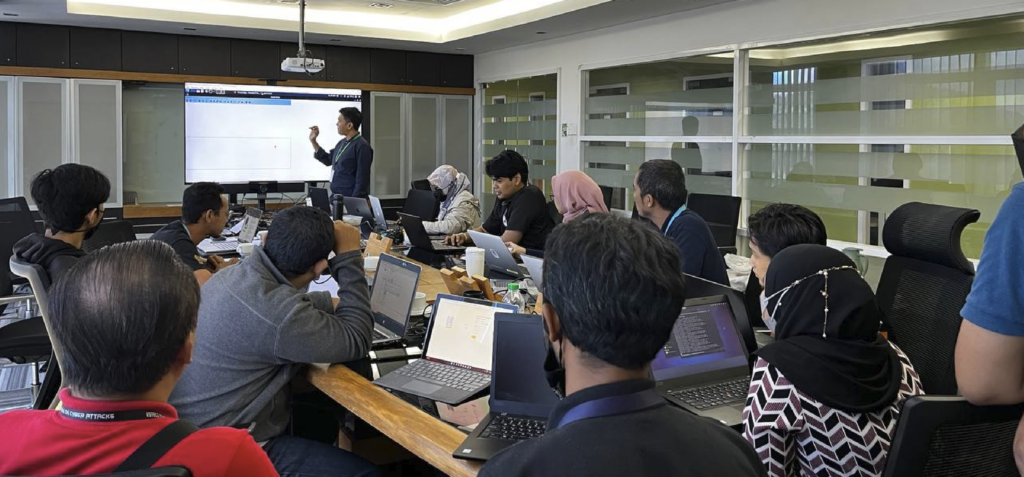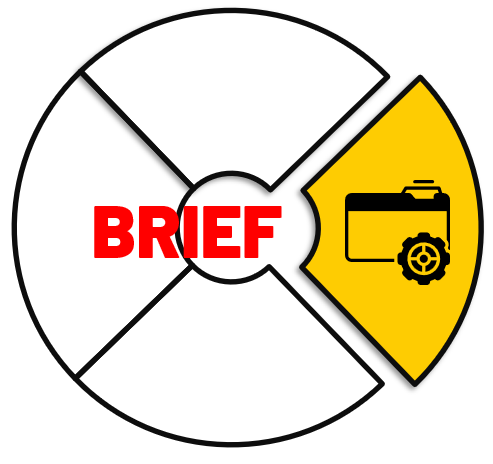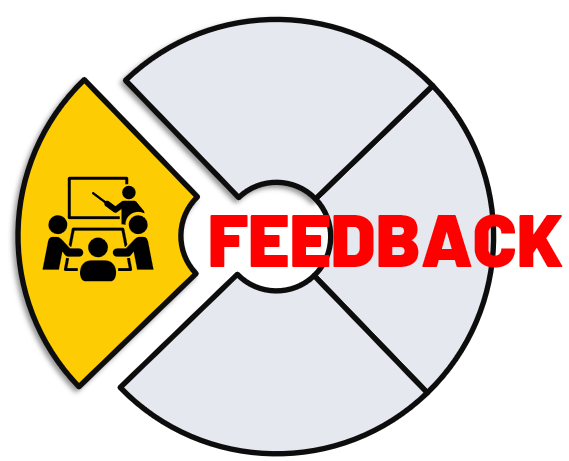
The methodology of a CD-X outlines the systematic approach used to organize cyber drill effectively and successfully. It ensures that the drill is affordable, realistic, organized, and delivers measurable outcomes. A solid methodology aligns the drill with organizational objectives and enables participants to develop the skills and insights needed to respond effectively to cyber incidents.
CD-X divided the cyber drill methodologies to 5 main topics:
- Sponsors
- Setup
- Brief
- Play (execution)
- Feedback (evaluate) a cybersecurity exercise.
Why This Methodology Matters
A well-structured methodology ensures that cyber drills are not ad hoc events but deliberate, impactful exercises. By following a clear methodology, organizations can:
- Test and strengthen their defenses.
- Foster a culture of preparedness and continuous improvement.
- Protect their operations, reputation, and stakeholders effectively.
1. Sponsors Come First

Why We Need a Sponsor for Our Cyber Drill
A sponsor is essential for the success of a cyber drill because they provide the necessary leadership, resources, and support to ensure the initiative delivers meaningful results.
- Ensure organizational support
- Provides funding and resources
- Align the drill with business goals
- Drives strategic outcomes
- Set the tone for the organizations
- Support cross-functional coordination
- Enhances the drill’s credibility and impact
CD-X provided the example of documentation to find sponsorship for cyber drill programs:
Download here: Proposal to Secure Sponsorship for Cyber Drill Initiative 2025/2026.
2. Setup – Setting up the cyber drill

Detailed Methodology for the Setup Phase in a Cyber Drill
2.1. Define the Scope of the Drill
2.2. Assemble a Core Team
2.3. Design Scenarios
2.4. Prepare the Environment
2.5. Documentation and Resources
2.6. Conduct a Pre-Drill Walk through
2.7. Communicate with Participants
- Briefing:
- Schedule pre-drill meetings to explain the exercise purpose and setup.
- Provide participants with logistical details, including timelines and roles.
- Setting Expectations:
- Emphasize the learning and improvement aspect of the drill, rather than focusing on individual performance.
2.8. Establish Evaluation Metrics
2.9. Emergency Procedures
- Contingency Plan:
- Establish procedures for unexpected interruptions during the drill (e.g., a real security incident).
- Assign a White Team member to coordinate drill pauses or cancellations if needed.
2.10. Finalize Logistics
3. Briefing – bring everyone together and align

Methodology for the Briefing Phase in a Cyber Drill
The briefing phase is where all participants are prepared and aligned on the goals, roles, rules, and expectations of the cyber drill. This ensures that everyone is on the same page and the exercise proceeds smoothly and effectively.
3.1. Set the Tone
3.2. Communicate Goals and Objectives
3.3. Provide an Overview of the Exercise
- Scenario Background:
- Share an overview of the scenario to provide context, without giving away specifics (e.g., “This exercise will focus on a ransomware attack simulation.”).
- Set realistic expectations about the scope and complexity of the scenario.
- Structure and Timeline:
- Walk through the drill phases (e.g., initiation, active phase, debriefing).
- Highlight key milestones and timing (e.g., start time, breaks, end time).
- Injects:
- Explain that additional challenges (injects) may be introduced during the exercise to test adaptability and resilience.
3.4. Define Roles and Responsibilities
3.5. Establish Rules of Engagement (RoE)
3.6. Share Supporting Materials
3.7. Cover Safety and Emergency Measures
3.8. Motivate Participants
3.9. Conduct a Q&A Session
3.10. Final Checklist and Acknowledgement
4. Play (Playtime) – Cyber drill execution

Methodology to Perform Play (Play-Time) During Cyber Drill Execution
The execution phase of a cyber drill, often called “play or play-time” is the centerpiece of the exercise. This phase tests the organization’s detection, response, and mitigation capabilities against a simulated cyber threat in real time. Below is a step-by-step methodology for the playtime phase to ensure an effective and structured execution:
4.1. Initiate the Scenario
Follow the scenario has been briefed during the briefing session.
- Purpose: Gradually introduce the simulated incident to reflect real-world attack dynamics.
- Steps:
- Start with an initial event, such as suspicious activity in logs, a phishing email, or malware alert, to initiate the drill.
- Let the team identify and escalate the issue naturally without excessive guidance.
Example:
- SOC receives an alert about unusual outbound traffic from a server, mimicking data exfiltration.
4.2. Observe Real-Time Reactions
4.3. Present Scenario Updates Dynamically
4.4. Ensure Controlled Chaos
- Purpose: Mimic the high-pressure environment of a real attack without compromising safety.
- Techniques:
- Use an isolated testing environment or simulated logs to avoid real-world impacts.
- Allow room for errors while ensuring that the simulation stays on track.
- Prevent over-guidance to maintain realism but step in if the drill veers off-course.
Example: If teams misuse actual tools that could disrupt operations, pause the drill to redirect efforts.
4.5. Encourage Decision-Making and Collaboration
- Purpose: Evaluate how effectively participants make decisions under pressure.
- Steps:
- Force participants to make real-time decisions on containment, eradication, and recovery.
- Monitor if team members adhere to pre-defined playbooks and escalate to leadership when appropriate.
- Assess cross-department collaboration, particularly for non-technical roles like legal, HR, and public relations.
Example: SOC identifies ransomware on a critical server. Teams must decide: shut down the server immediately or isolate it first while notifying leadership.
4.6. Monitor Key Performance Metrics
- Purpose: Collect data to evaluate performance during the post-drill analysis.
- Metrics to Monitor:
- Time to detect the incident.
- Time to escalate the issue.
- Containment and recovery timelines.
- Effectiveness of internal and external communication.
- Gaps in coordination between teams or playbooks.
Example Metric: SOC detected the incident within 15 minutes but took 2 hours to inform leadership due to communication bottlenecks.
4.7. Engage Control and Observation Teams
4.8. Handle Injects and Stress Points
4.9. Facilitate Role-Playing
4.10. End the Drill Gracefully
- Purpose: Ensure that the drill has a structured conclusion and transitions to evaluation.
- Actions:
- Announce when the exercise is complete.
- Begin immediate debriefs with participants to capture insights while events are fresh.
- Transition into post-drill evaluation and lessons learned.
Example: End the drill after teams submit their containment and mitigation report or simulate achieving full recovery.
Summary of Playtime Focus Areas
- Simulate scenarios realistically and dynamically.
- Monitor team detection, decision-making, and communication.
- Collect metrics on performance, including timing and adherence to protocols.
- Engage control and observation teams for smooth execution and documentation.
- Ensure all participants understand when the exercise ends and move seamlessly into analysis.
5. Feedback – Post Engagement Cyber Drill

Methodology for the Feedback (Post-Engagement) Phase in a Cyber Drill
The feedback phase, often referred to as the post-engagement or debriefing phase, is crucial for extracting actionable insights and identifying areas for improvement after the cyber drill. Here’s how to structure and conduct this phase effectively:
5.1. Immediate Hotwash Session
- Purpose: Quickly gather initial feedback while the experience is fresh.
- Participants: All key teams (Red, Blue, and White teams, and observers).
- Process:
- Facilitate an open, structured discussion.
- Focus on high-level observations rather than detailed analysis.
- Ask each team to share:
- What went well.
- What challenges they faced.
- Immediate lessons learned.
- Document these insights for deeper analysis later.
5.2. Collect Detailed Feedback
- Methods:
- Conduct surveys or questionnaires with structured and open-ended questions. Examples:
- How prepared did you feel for your role?
- Were the provided resources and tools sufficient?
- Which aspects of the drill were the most/least effective?
- Gather logs and metrics from tools and systems used during the drill.
- Conduct surveys or questionnaires with structured and open-ended questions. Examples:
- Key Areas to Cover:
- Team communication and coordination.
- Effectiveness of detection and response processes.
- Technology performance and gaps.
- Scenario realism and relevance.
5.3. Data Analysis
- Purpose: Analyze both qualitative and quantitative data to uncover trends and patterns.
- Process:
- Review system logs and monitoring data:
- Time to detect the incident.
- Time to escalate and contain.
- False positives or missteps in response actions.
- Compare observed actions with the organization’s incident response plan (IRP).
- Identify decision points where teams succeeded or struggled.
- Note discrepancies between expected and actual team responses.
- Review system logs and monitoring data:
5.4. Develop a Post-Drill Report
- Content:
- Executive Summary: Key findings, high-level insights, and outcomes.
- Overview: Objectives, scope, and scenario details.
- Performance Metrics:
- Time-based metrics (e.g., detection time, containment time).
- Success rates for containment or mitigation efforts.
- Strengths:
- Highlight areas where the teams performed well.
- Gaps and Challenges:
- Identify weaknesses in processes, communication, tools, or training.
- Recommendations:
- Specific and actionable steps to improve people, processes, and technologies.
- Audience:
- Tailor the report to different stakeholders, including executives, IT leaders, and technical teams.
5.5. Present Findings to Stakeholders
- Purpose: Ensure all levels of the organization understand the results and the importance of the exercise.
- Process:
- Use visuals like charts and timelines to illustrate performance metrics and scenarios.
- Show before-and-after snapshots of team preparedness.
- Discuss how recommended changes align with organizational goals.
5.6. Plan Remediation Actions
- Address Gaps:
- Improve training in areas where teams under performed.
- Update and test technical tools or security policies as needed.
- Refine the incident response plan (IRP) to account for lessons learned.
- Assign Ownership:
- Ensure each improvement action has a designated owner and a clear timeline.
5.7. Evaluate and Enhance the Drill Process
- Improve Future Drills:
- Solicit feedback on how the drill was conducted (e.g., scenario complexity, inject effectiveness, rules of engagement).
- Update the methodology or scenario design based on participant feedback.
5.8. Conduct Follow-Up Sessions
- Revisit Changes:
- Schedule follow-up drills or tabletop exercises to test the effectiveness of implemented improvements.
- Measure Progress:
- Compare performance metrics in future drills to determine progress in response capabilities.
5.9. Reinforce a Culture of Continuous Improvement
- Celebrate Success:
- Acknowledge team efforts and highlight accomplishments during the drill.
- Encourage Openness:
- Foster an environment where constructive feedback and learning are valued.
